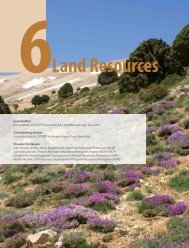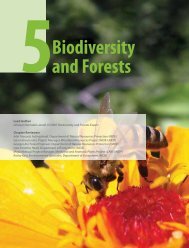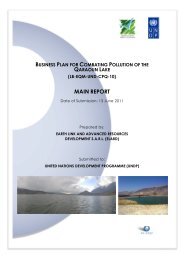Project for the preparation of a Strategic Action Plan for the ...
Project for the preparation of a Strategic Action Plan for the ...
Project for the preparation of a Strategic Action Plan for the ...
You also want an ePaper? Increase the reach of your titles
YUMPU automatically turns print PDFs into web optimized ePapers that Google loves.
SAP-BIO-Lebanon National Report Page 11 <strong>of</strong> 95<br />
¯¯¯¯¯¯¯¯¯¯¯¯¯¯¯¯¯¯¯¯¯¯¯¯¯¯¯¯¯¯¯¯¯¯¯¯¯¯¯¯¯¯¯¯¯¯¯¯¯¯¯¯¯¯¯¯¯¯¯¯¯¯¯¯¯¯¯¯¯¯¯¯¯¯¯¯<br />
Winds, waves and currents move pollutants progressively shoreward depositing organic matter, wood and<br />
solid waste along <strong>the</strong> shores, creating unsightly and sometimes dangerous conditions <strong>for</strong> <strong>the</strong> public.<br />
1.6. Nutrients<br />
The oriental basin <strong>of</strong> <strong>the</strong> Mediterranean is not as rich in nutrients as <strong>the</strong> occidental basin. Although <strong>the</strong>re<br />
are significant discharges <strong>of</strong> nitrates and phosphates into <strong>the</strong> sea through sewers and rivers, Lebanon's<br />
coastal waters have not experienced any eutrophication problems or toxic algae blooms so far.<br />
2. Marine and Coastal biodiversity<br />
The marine and coastal flora and fauna in Lebanon are considered to be Mediterranean with some subtropical<br />
elements. Phytoplankton, which includes all microphytic algae, constitutes <strong>the</strong> basis <strong>of</strong> <strong>the</strong> food<br />
chain in <strong>the</strong> sea through <strong>the</strong>ir primary productivity. The micro and macrophytic benthic algae are highly<br />
affected by coastal pollution.<br />
In addition, macro-zooplankton are highly abundant in <strong>the</strong> Lebanese water and <strong>of</strong> various types, including<br />
crustaceans, which are prevalent, as well as fish species that are disturbed by early fishing and unsafe<br />
fishing methods. Urbanization, industry, domestic wastes, garbage and illegal fishing methods are<br />
stressing and damaging local biodiversity. Because <strong>of</strong> <strong>the</strong> coastal sand and pebble extraction and<br />
urbanization, <strong>the</strong> sighting <strong>of</strong> turtles and Mediterranean monk seals is a rare phenomenon, even though<br />
<strong>the</strong>re is a recent unconfirmed report <strong>of</strong> sighting <strong>of</strong> monk seals in North Lebanon. However, frequent<br />
sightings <strong>of</strong> marine turtles and nesting sites have been confirmed in <strong>the</strong> past two years in different<br />
locations <strong>of</strong> <strong>the</strong> Lebanese coast. The sea horse is also severely threatened by loss <strong>of</strong> habitat. Of particular<br />
significance is <strong>the</strong> loss <strong>of</strong> local terraces that are rich in biodiversity and unique to this part <strong>of</strong> <strong>the</strong><br />
Mediterranean (Anonymous, 1998, NBSAP).<br />
The coastal waters, however, allow <strong>for</strong> a potentially rich biological system. The Lebanese marine<br />
ecosystem comprises 1685 species <strong>of</strong> fauna <strong>of</strong> which 50 are commercially important fish species. The<br />
number <strong>of</strong> planktonic primary and secondary producers is over 1250 species (Anonymous, 1998,<br />
NBSAP). These await proper documentation and conservation because <strong>the</strong>y are subjected to pollution<br />
from land based sources (industry, sewage discharges, power plants and oil lines just to mention a few).<br />
It is <strong>for</strong>tunate however, that <strong>the</strong>re are still a few coastal areas that have preserved <strong>the</strong>ir natural biotopes<br />
and beauty. These, toge<strong>the</strong>r with a number <strong>of</strong> river valleys, must be properly identified and protected.<br />
Two coastal nature reserves were declared by law: “Tyre Coast Nature Reserve” (Decree 708,<br />
12/11/1998) and <strong>the</strong> “Palm Islands Nature Reserve” (Decree 121, 12/03/1992). Four RAMSAR sites have<br />
been declared in Lebanon, with three coastal: “Tyre Coast Nature Reserve”, “Palm Islands Nature<br />
Reserve” and “Ras El Chaqaa”. It is precisely along this thinking and by providing refuge that marine<br />
turtles, after a long absence, have recently been spotted. A recent study indicated that <strong>the</strong>re are currently<br />
19 beaches (12 south <strong>of</strong> Beirut and 7 north <strong>of</strong> Beirut) that represent potential nesting habitats (Demirayak<br />
et al. 2002).<br />
Apart from <strong>the</strong> two coastal nature reserves three atypical coastal habitats need to be conserved in order to<br />
protect rare plants and landscapes <strong>of</strong> biological interest. These are river mouths, coastal dunes and coastal<br />
springs. Remaining typical coastal habitats include sandy beaches, rocky beaches, abandoned fields, and<br />
cliffs and cliff faces. These harbor typical littoral plant communities.<br />
___________________________________________________________________________________________<br />
Prepared By M. Nader & S. Talhouk June, 2002





